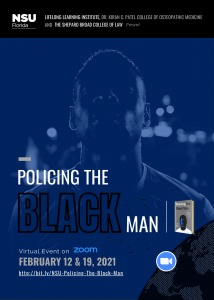Free Two-Day Virtual Event Open to All Members of the Community
Features Prominent Figures in Law Enforcement, the Judicial System and Education
WHO: Officials from Nova Southeastern University’s Shepard Broad College of Law, the College of Psychology and the Lifelong Learning Institute, along with:
- Gregory Tony, Broward County Sheriff;
- Harold Pryor, Broward State Attorney;
- Gordon Weekes, Broward County Public Defender;
- Dale V.C. Holness, Broward County Commissioner, District 9; and
- Angela J. Davis, Distinguished Professor, American University Washington College of Law, and one of the authors of “Policing The Black Man: Arrest, Prosecution And Imprisonment”
WHAT: Two-day virtual symposium: “Policing the Black Man: Arrest, Prosecution And Imprisonment,” which examines how the judicial system interacts with the African-American Community.
WHERE: Each day’s presentation will take place online via Zoom
- Registration online HERE
- Event program online HERE
WHEN:
- Friday, Feb. 12 10 a.m. – 3:30 p.m.
- Friday, Feb. 19, 1:30 – 4:30 p.m.
WHY: The continuing plague of abuse by law enforcement of African Americans, and African American men in particular, led to last year’s widespread protests. As a new presidential administration takes office, there is an opportunity to advance changes that can help to address this fundamental challenge facing our nation. Interested community members are encouraged to join in for an examination of the many challenges and how to address them.
The first day of the program will begin with a presentation by the leading lawyers and legal scholars who co-authored a book that addresses this precise issue: “Policing the Black Man: Arrest Prosecution and Enforcement.” Law enforcement officials and elected officials will examine the impact on the criminal legal system.
A week later, the conversation will continue with an analysis of the issue by community leaders and activists to examine the impact on society. The results of the discussion will be used to identify steps to undertake to address these challenges. This is an important conversation that must continue.

 Saturday, February 5, 2022
Saturday, February 5, 2022
















